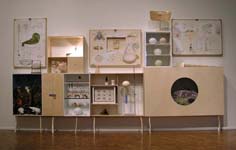
“Propaganda works best when it is underhand. I don’t want to hit people over the head with the message,” Olga Bergmann said when asked about the strong message concealed beneath the light, pure surface of her works.
Science, nature and the world of man is a trinity that is regularly combined in Olga Bergmann’s art.
She makes extensive use of found objects, handling them to different extents, incorporating them into her works and creating another reality from them.
Just as man uses science to transform nature, Olga Bergmann
transforms the objects she uses in her works. Chimeras and other
hybrid and mythological beings often occur. These are beings that pose no threat; they are slightlty absurd and cute in a parochial sort of way. Nonetheless the subversive propaganda is constantly on the prowl, a cute dog with wide eyes and little trees instead of ears insinuates the notion that genetically modified animals are possibly a rather suspect idea.
In her Museum, nature appears in the form of animals, biopsies in test tubes and scientific schemata that the artist has altered. These include a horn that appears to be from a unicorn and two little invented animals that look like they are being kept in cages for laboratory experiments.
Science appears in the laboratory equipment and the systematically
arranged exhibition items in their respective compartments.
The human world manifests itself in the stories that the spectator can read from the work, allowing us to take part in its creation. It inspires memories of museums, classrooms and institutions that we have
encountered over the years - thus we create a vision of the future from our past. The contrasts in the work create tension and energize it: for example, infallible science is juxtaposed with chimeras and other legendary beasts. Science is constantly searching for new truths and can therefore only offer us imperfect reality, a situation that will have to suffice until something more correct is proven - such is the nature of science. The imperfection of memories is also something that most of us recognize, and in both these cases we make up for shortcomings with fables and fantasies. In Museum this all merges into a single, stratified whole which, in a a haunting way is
familiar.
The oldest European museums began as collections made by royalty or rich people and were generally collections of interesting objects. Such cabinets of curiosa contained both certified museum pieces and more dubious ones. Olga Bergmann´s collections recall them, but her version links the past with a vision of the future. The version of the future that she presents is soft and sweet and underlines the fantasy rather than the horror and is classified as steam punk.
Olga Bergmann uses humour to seduce the spectator into a seamless world that at the same time is a satire on the direction our own reality appears to be taking.
Dagur Gunnarsson
The largest cupboard contains a sample of unspoilt nature in the form of a small mountain.
One cupboard is locked, lending the work a sense of mystery.
The cupboards stand in a row on polished branches, which are slightly knotty and bent.
